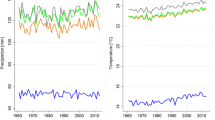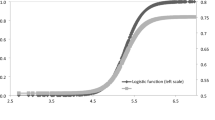Abstract
This study aims to examine the impact of (i) climate change and international market price volatility on cotton production in Cameroon, (ii) climate change and international market price volatility on the prices of cotton farmers, (iii) the purchase price of cotton farmers on cotton production, (iv) cotton production on the purchase price of cotton farmers. The statistics used mainly come from the SODECOTON database, the World Bank Group Climate Change Knowledge Portal and Trading Economics. Econometric estimates made using a VAR model reveal that (i) the purchase price of seed cotton tends to significantly boost production, (ii) production does not significantly influence the purchase price of seed cotton, and (iii) the increase in the world price of cotton and significant variations in temperature are conducive to a revaluation of the purchase price of seed cotton. To improve cotton production, it would be advisable, in particular, to (i) make the purchase price of seed cotton more attractive to cotton growers and (ii) adopt effective adaptation or mitigation techniques against variations in rainfall.
Résumé
Cette étude vise à examiner l’incidence (i) du changement climatique et de la volatilité des prix du marché international sur la production cotonnière au Cameroun, (ii) du changement climatique et de la volatilité des prix du marché international sur le prix aux cotonculteurs, (iii) du prix d’achat aux cotonculteurs sur la production cotonnière, (iv) de la production cotonnière sur le prix d’achat aux cotonculteurs. Les statistiques utilisées proviennent essentiellement de la base de données de la SODECOTON, la World Bank Group Climate Change Knowledge Portal et la Trading Economics. Les estimations économétriques effectuées à l’aide d’un modèle VAR révèlent que (i) le prix d’achat du coton graine tend à booster significativement la production, (ii) la production n’influence pas significativement le prix d’achat du coton graine et (iii) l’augmentation du cours mondial du coton et les variations importantes des températures sont propices à une revalorisation du prix d’achat du coton graine. Pour améliorer la production du coton, il serait judicieux notamment (i) de rendre incitatifs les prix d'achat du coton graine aux cotonculteurs et (ii) d’adopter des techniques d'adaptation ou d'atténuation efficaces contre les variations de la pluviométrie


Source Author, using data from the World Bank Group Climate Change Knowledge Portal (2017)

Source Author based on SODECOTON data (SODECOTON: Cotton Development Company)

Source Author based on SODECOTON data
Similar content being viewed by others
References
Adams, R.M., B.A. McCarl, K. Segerson, C. Rosenzweig, K.J. Bryant, B.L. Dixon, R. Conner, R.E. Evenson, and D. Ojima. 1998. The economic effects of climate change on U.S. agriculture, Chap 2. In The economics of climate change, ed. R. Mendelsohn and J. Neumann. Cambridge: Cambridge University Press.
Baffes, J., and B. Gardner. 2003. The transmission of world commodity prices to domestic markets under policy reforms in developing countries. Journal of Policy Reform 6 (3): 159–180.
Barrere, C. 2002. Comprendre la formation des prix contemporains: les limites de l’analyse marxienne, 2dité par J. ,C., Delaunay Le Capitalisme Contemporain: des Theorisations Nouvelles?, Publié dans l’Harmattan, 1–23.
Barrios, S., B. Ouattara, and E. Strobl. 2008. The impact of climatic change on agricultural production: Is it different for Africa? Food Policy 33 (4): 287–298.
Bourdet, Y. 2004. A Tale of three countries—Structure, Reform ad Performance of the Cotton Sector in Mali, Burkina Faso and Benin, Swedish International Development Authority, Stockholm. Country Economic report, No 2.
Butt, T., B. McCarl, J. Angerer, P. Dyke, and J. Stuth. 2005. The economic and food security implications of climate change in Mali. Climatic Change 68: 355–378.
Camera, M. 2014. L’analyse des facteurs influents la production de coton en Afrique de l’Ouest. Les Cahiers de l’Association Tiers-Monde, No 29: 259–268.
Cariolle, J. 2012. Mesurer l’instabilité macroéconomique : application aux données de recettes d’exportation 1970–2005. FERDI: Document de travail.
Centre du Commerce International. 2011. Stratégie de développement de la filière coton-textile-confection en Afrique Centrale, Document de travail.
Chang, C.-C. 2002. The potential impact of climate change on Taiwan’s agriculture. Agricultural Economics 27: 51–64.
Collange, G., and F. Guillaumat-Tailliet. 1988. les déterminants des prix des matières premières: une analyse économétrique. Observations et diagnostics économiques: revue de l’OFCE 25 (01): 145–171.
Dallery, T., F. Eloire, and J. Melmiès. 2009. La fixation des prix en situation d’incertitude et de concurrence : Keynes et White à la même table. Revue Française de Socioéconomie 2 (4): 177–198.
Darwin, R., M. Tsigas, J. Lewandrowski, and A. Raneses. 1995. World agriculture and climate change: economic adaptations. Agricultural Economic Report No. 703. Natural Resources and Environmental Division, Economic Research Service, U.S. Department of Agriculture, Washington, DC.
Deressa, T., R. Hassan, and D. Poonyth. 2005. Measuring the impact of climate change on South African agriculture: The case of sugar-cane growing regions. Agrekon 44 (4): 524–542.
Dieng, A. 2006. impacts des politiques agricoles sur l'offre Céréalière au sénégal, de 1960 à 2003 : Évaluation à partir d'un modèle d'analyse Statistique par zones agro-écologiques, Thése de doctorat dirigée par Kroll, J.,C., Université de Bourgogne.
Elbehri, A., and M. Burfisher. 2015. Economic modelling of climate impacts and adaptation in agriculture: a survey of methods, results and gaps. In Climate change and food systems: Global assessments and implications for food security and trade, ed. FAO, 107–145.
FAO. 2017. Perspectives de alimentation: les marches en bref. Document de travail du SMIAR. www.fao.org/giews.
Gbetibouo, G.A., and R.M. Hassan. 2005. Measuring the economic impact of climate change on major South African field crops: a Ricardian approach. Global and Planetary Change, No 47: 143–152.
Gnos, C. 2000. Les Grands auteurs en économies. Editions EMS.
Harmignie, O., P. Polomé, B. Henry de Frahan, and F. Gaspart. 2005. Analyse d’outils de gestion des risques agricoles en Région wallonne. Unité d’économie rurale, Faculté d’ingénierie biologique, agronomique et environnementale, Université catholique de Louvain, décembre 2005.
Hauchart, V. 2008. Culture du coton, pluviosité et dégradation des sols dans le Mouhoun (Burkina Faso). Sécheresse 19: 95–102.
Hazell, P., M. Jaramillo, and A. Williamson. 1990. The relationship between world price instability and the prices farmers receive in developing countries. Journal of Agricultural Economics 41 (2): 227–241.
Hugon, P., and A. Mayeyenda. 2003. Les effets des politiques des prix dans les filières coton en zone franc : une analyse empirique. Economie Rurale 275: 66–82.
Hugon, P., G. Pourcet, and V.S. Quiers. 1994. L’Afrique des incertitudes, 272. Paris: PUF.
Institut National de la Statistique. 2017. ECAM 4: Profil de la pauvreté monétaire, document de travail de l’INS
Le Treut, H. 2004. Comment je vois le monde, Evolution climatique: les modeles et leurs limites, edité par Le Treut, H., Jancovici, J., M., Effet de serre : allons-nous changer le climat ?, Flammarion: Editions Champs.
Leclerc, C., C. Mwongera, P. Camberlin, and V. Motron. 2014. Cropping System dynamics, climate variability, and seed losses among East African smallholder farmers: A retrospective survey. Weather, Climate and Society 6: 354–370.
Lobell, D.B., M.B. Burke, C. Tebaldi, M.D. Mastrandrea, W.P. Falcon, and R.L. Naylor. 2008. Prioritizing climate change adaptation needs for food security in 2030. Science 319 (5863): 607–610.
Lobell, D.B., and S.M. Gourdji. 2012. The influence of climate change on global crop productivity. Plant Physiology 160: 1686–1697.
Lobell, D.B., W.S. Schlenker, and J. Costa-Roberts. 2011. Climate trends and global crop production since 1980. Science 333: 616–620.
Maddison, D., M. Manley, and P. Kurukulasuriya. 2007. « The Impact of Climate Change on African Agriculture : a ricardian approach », World Bank, Policy Research Working Paper, No 4306.
Mendelsohn, R., W. Nordhaus, and D. Shaw. 1994. ‘The impact of global warming on agriculture: A Ricardian analysis. American Economic Review 84 (4): 753–771.
Ministère du Commerce du Cameroun. 2017. Tradestat: annuaire statistique sur le commerce du Cameroun.
Minot, N. 2012. Food price volatility in Africa: Has it really increased?. Discussion paper No.01239, International Food Policy Research Institute.
Mpabe, B.M.J., Fondo Sikod, and N.G. Olinga. 2017. On the Necessity of Modifying the Mechanism of Price Risk Management of the Cotton Sector in Cameroon. In Cameroon in the 21st century: Challenges and prospects, Volume 1 Governance and businesses, ed. I. Piot-Lepetit. Nova Publisher.
Müller, C., A. Bondeau, A. Popp, K. Waha, and M. Fader. 2009. Climate Change Impacts on Agricultural Yields. Note de référence pour le Rapport sur le développement dans le monde 2010.
Mundlak, Y., and D. Larson. 1992. On the transmission of world agricultural prices. World Bank Economic Review 6 (3): 399–422.
Mwongera, C., J. Boyard-Micheau, C. Baron, and C. Leclerc. 2014. Social process of adaptation to environmental changes: How Eastern African societies intervene between crops and climate. American Meteorological Society 6: 341–353.
Nelson, G. C., M.W. Rosegrant, J. Koo, R. Robertson, T. Sulser, T. Zhu, C. Ringler, S. Msangi, A. Palazzo, M. Batka, M. Magalhaes, R. Valmonte-Santos, M. Ewing, and D. Lee. 2009. Climate change: Impact on agriculture and costs of adaptation. Food Policy Report 21. Washington, DC: International. Food Policy Research Institute (IFPRI). http://www.ifpri.org/publication/climate-change-1
Nubukpo, K.K. 2006. Le piège du coton : le Mali à la croisée des chemins. OCL 13 (4): 278–284.
Nubukpo, K.K., and M.S. Keita. 2005. L’impact sur l’économie malienne du nouveau mécanisme de fixation du prix du coton graine ». Etude commanditée par Oxfam.
OCDE. 2008. Rising food prices: Causes and consequences. Document de travail de l’OCDE.
Ouedraogo, M. 2012. Impact des changements climatiques sur les revenus agricoles au Burkina Faso. Journal of Agriculture and Environment for International Development 106 (1): 3–21.
Paeth, H., A. Capo-Chichi, and W. Endlicher. 2008. Climate Change and food security in tropical West Africa: A dynamic-statistical modelling approach. Erdkunde 62: 101–115.
Parry, M.L., C. Rosenzweig, A. Iglesias, M. Livermore, and G. Fischer. 2004. Effects of climate change on global food production under SRES emissions and socio-economic scenarios. Global Environmental Change 14: 53–67.
Parry, M.L., O.F. Canziani, J.P. Palutikof, P.J. Van der Linden, and C.E. Hanson. 2007. Climate change 2007: Impacts, adaptation and vulnerability: Contribution of working group II to the fourth assessment report of the intergovernmental panel on climate change. Cambridge: Cambridge University Press.
Rosenzweig, C., and M.L. Parry. 1994. Potential impacts of climate change on world food supply. Nature 367: 133–138.
Rötter, R., and J. Höhn. 2015. An overview of climate change impact on crop production and its variability in Europe, related uncertainties and research challenge, ed. FAO (2015), Climate change and food systems: Global assessments and implications for food security and trade, 107–145.
Sims, C.A. 1980. Macroeconomics and reality. Econometrica 48 (1): 1–48.
Singh, B., and M. J. Cohen. 2014. Adaptation aux changements climatiques: Le cas d’Haïti. Rapport de recherché OXFAM. www.oxfam.org
Subervie, J. 2007. La transmission de l’instabilité des prix agricoles internationaux et ses conséquences dans les pays en développement. Thèse de doctorat dirigée par Araujo-Bonjean, C., & Guillaumont, P., Université d’Auvergne-Clermont-Ferrand I
Sultan, B., P. Roudier, P. Quirion, A. Alhassane, B. Muller, M. Dingkuhn, P. Ciais, M. Guimberteau, S. Traore, and C. Baron. 2013. Assessing climate change impacts on sorghum and millet yields in the Sudanian and Sahelian savannas of West Africa. Environmental Research Letters 8 (014040): 1–9.
Temple, L., V. Meuriot, and M. Ali. 2009. Déterminants de l’instabilité des prix alimentaires au Cameroun: une analyse institutionnelle de résultats économétriques, Document de travail du FARM & CIRAD
Tingem, M., M. Rivington, G. Bellocchi, S. Azam-Ali, and J. Colls. 2003. Effects of climate change on crop production in Cameroon. Climate Research 36: 65–77.
Trnka, M., J.E. Olesen, K.C. Kersebaum, A.O. Skjelvåg, J. Eitzinger, B. Seguin, P. Peltonen-Sainio, R. Rötter, A. Iglesias, and S. Orlandini. 2011. Agroclimatic conditions in Europe under climate change. Global Change Biology 17: 2298–2318.
Author information
Authors and Affiliations
Corresponding author
Additional information
Publisher's Note
Springer Nature remains neutral with regard to jurisdictional claims in published maps and institutional affiliations.
Appendix
Rights and permissions
About this article
Cite this article
Mpabe Bodjongo, M.J. Climate Change, Cotton Prices and Production in Cameroon. Eur J Dev Res 34, 22–50 (2022). https://doi.org/10.1057/s41287-020-00345-1
Accepted:
Published:
Issue Date:
DOI: https://doi.org/10.1057/s41287-020-00345-1





